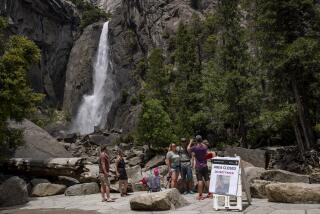Yosemite Plan to Cut Vehicle Use, Put Nature First
- Share via
Hoping to revitalize heavily used Yosemite National Park, federal officials will announce a sweeping proposal Monday to dramatically cut vehicle use and let nature take back some of the heart of the nearly century-old park.
The ambitious project would reduce and centralize day-use parking and restore large tracts of undeveloped land in Yosemite Valley, especially along the Merced River, according to sources familiar with the plan.
The plan does not go as far as a proposal made two decades ago that envisioned the removal of all private vehicle traffic from the 7-mile-long, mile-wide valley.
But supporters said Saturday that the new draft proposal will address much of the environmental degradation and crowding that some say have overshadowed the splendor of El Capitan and Half Dome, the valley’s famous granite monoliths. They said the comprehensive proposal would preserve the valley for generations to come, but without overly onerous restrictions on visitors.
“This plan will give people an opportunity to experience the magnificence of Yosemite,” said park Supt. David A. Mihalic, who pushed for the quick drafting of the plan. “The difference now will be they might take a shuttle instead of driving in all the way. And they will be able to experience more scenic beauty, enhanced wildlife and a more natural river system and spend less time looking for parking or dealing with lots of people or congestion.”
Representatives from the Wilderness Society, the Natural Resources Defense Council and the National Parks Conservation Assn. expressed support for the National Park Service, even before the release of the specifics. “I’m confident that the Park Service will follow a trail to a grand plan for Yosemite,” said Jay Watson, regional director of the Wilderness Society.
Interior Secretary Bruce Babbitt will disclose details of the long-awaited proposal during a speech at the Commonwealth Club in San Francisco on Monday.
Called the Yosemite Valley Plan, the project could cost as much as $343 million to implement in stages during the next decade if it is approved. Public hearings will be held through the summer, and Supt. Mihalic and the Park Service’s Western Region director are expected to make a final decision on the plan by year’s end. Among the highlights:
* Visitors would be encouraged to leave their cars outside the valley. They could take shuttle buses from parking lots at El Portal, Badger Pass and Crane Flat to a new transit center and then to the park’s top destinations. The number of parking spaces for day use would be reduced from more than 1,600 to 550, all at Yosemite Village.
* The number of lodging rooms in the valley would be reduced from 1,260 to 981 by removing cabins at Curry Village and Housekeeping Camp. Yosemite Lodge would be allowed to replace more than 100 units lost to a 1997 flood, bringing its total number of rooms to 386. And the landmark Ahwahnee Hotel would remain at 123 rooms.
* A 3.2-mile section of one of Yosemite’s main roads, Northside Drive, would be eliminated. It would be replaced by a paved trail on which pedestrians and bicyclists could travel roughly from El Capitan to Yosemite Village.
* About 180 acres would be restored to their natural state, including Ahwahnee and Stoneman meadows, by removing roads, trails and some structures.
* Three bridges and a dam on the Merced River would be removed to reduce erosion along the riverbank. A 150-foot protection zone would be imposed on both sides of the river and almost all development moved outside that area. Indigenous shrubs and trees such as willows and black oak would be planted in some of these areas.
* The number of campsites would be reduced from 475 to 465, and nearly 100 would be walk-in campsites, accessible on foot but without immediate parking for cars. The walk-in sites are designed to take less space and help preserve the natural habitat. Valley campgrounds would also get an undetermined number of pay showers and recreational vehicle hookups--both innovations.
* There would be attempts to enhance public enjoyment of key attractions like Yosemite Falls. There, a viewing area and interpretive center would be improved and a parking lot removed to allow visitors to enjoy the setting away from cars and as many as 50 buses that have stopped there on peak summer days.
“We’re very happy,” said Brian Huse, the Pacific region director for the National Parks Conservation Assn. “We’re looking at a plan that is very proactive and is a tremendous step in reducing traffic congestion in Yosemite Valley.”
The plan will not have easy going with some groups, however. Some “gateway” communities have been fearful that discouraging automobile traffic might damage their fragile economies. And members of the Sierra Club committee studying the park have said it is time to place limits on public access to the valley.
“Unless the administration is willing to introduce some limits [on the number of visitors], then the park is doomed,” said George Whitmore, chairman of the Sierra Club committee. “Yosemite is not going to be a very nice place if everyone is allowed to go there whenever they want to. Mr. Babbitt is unwilling to address that.”
Up to 80% of Yosemite’s visitors come just for a day, nearly all of them in cars. On summer weekends, more than 14,000 vehicles converge on the narrow Yosemite Valley.
Supporters of the plan say it could cut traffic in Yosemite by up to 50%. This would be accomplished by limiting car traffic to the proposed transit center and using shuttles to bring other visitors there from the three outlying parking lots.
One of the satellite lots would be off Highway 41 near the Badger Pass ski area. The second is proposed for an area on the north side of Highway 120 near Crane Flat. The third would be off Highway 140 near El Portal, by the western entrance to the park.
A transit management station would attempt to direct tourists to the best parking locations. Eventually, the center might require drivers to get reservations to park their cars. It could use electronic messages at entrances, or it might encourage parking at more distant lots by charging a premium to park in the valley. Those details remain to be worked out.
The El Portal area is the site of other proposed changes. The park headquarters might be moved there from the valley, or to another location. The superintendent’s house would be relocated there. A majority of employee housing--the bulk of it for concession workers--also would be at El Portal instead of in the valley.
Along the Merced River, the Stoneman, Sugar Pine and Ahwahnee bridges would be removed.
The Cascade Dam, which is old and not maintained, also would be removed from the Merced River.
The stables would be removed, because of crowding and conflicts with pedestrians. Visitors could bring their own horses to ride.
Mihalic predicted that weeks of public hearings around the state and nation will be spirited.
“This is only a draft plan,” said Mihalic. “We expect people will have plenty to say to make it better.”
(BEGIN TEXT OF INFOBOX / INFOGRAPHIC)
Yosemite Changes
The following changes are proposed for Yosemite National Park:
*
Northside Drive may be closed to vehicle traffic from El Capitan (not shown) to Yosemite Village and converted to a pedestrian trail. Southside Drive, now one way for vehicle traffic, may be converted to a two-way road.
*
Additional parking may be added at Crane Flat, El Portal and Badger Pass.
*
Living units in Yosemite Valley may be reduced from a total of 1,260 to 981, with reductions occurring at Housekeeping Camp and Curry Village.
*
Park headquarters may move to El Portal.
More to Read
Sign up for Essential California
The most important California stories and recommendations in your inbox every morning.
You may occasionally receive promotional content from the Los Angeles Times.












